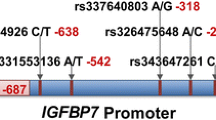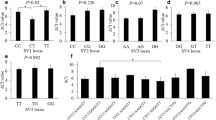Abstract
As a kind of E3 ligase, the product of FBXL4 gene belongs to a member of FBLs which is the biggest eukaryotic subfamily of F-BOX proteins, it can recognize some substrate through particular protein–protein interaction domains. To investigate its functions, the polymorphism and association analysis was analyzed. The partial cDNA of porcine FBXL4 with 2384 bp long was first cloned; the deduced protein comprises a conserved F-BOX domain at position from the 277th to 332nd amino acid. The phylogenetic tree indicated porcine FBXL4 has the closest genetic relationship with bovine FBXL4 than other selected animal species. Ten tissue expression level of porcine FBXL4 mRNA fluctuated remarkably in a large range by quantitative RT-PCR analysis. For two identified SNPs, the genotyping analysis of Tail showed TT genotype owned dominance in introduced Landrace pig and miniature Guizhou and Wuzhishan breeds, but CC genotype was more than two other genotypes in miniature Laiwu breed. While in another genotyping analysis of BsaJI, CC genotype was obviously more than other genotypes in two kinds of Chinese miniature pig breeds and introduced Landrace pig breeds. Furthermore, the association analysis with immune traits and blood parameters revealed that SNP Tail was significantly associated with the lymphocyte percentage (P = 0.0166) and the antibody levels for pseudorabies virus vaccination (P = 0.0001) of neonate piglets at 0 day. Meanwhile, SNP BsaJI was significantly associated with lymphocyte percentage of individuals at 32 days (P = 0.0351), neutrophil percentage (P = 0.0005), the absolute lymphocyte count (P = 0.0458), and the mixed cells (P = 0.0010) of neonate piglets at 0 day.




Similar content being viewed by others
References
Hershko A, Ciechanover A (1998) The ubiquitin system. Annu Rev Biochem 67:425–479
Bonnevier JL, Zhang R, Mueller DL (2005) Review E3 ubiquitin ligases and their control of T cell autoreactivity. Arthritis Res Ther 7:233–242. doi:10.1186/ar1842
Bai C, Sen P, Mathias N, Hofmann K, Ma L, Goebl M, Harper JW, Elledge SJ (1996) SKP1 connects cell cycle regulators to the ubiquitin proteolysis machinery through a novel motif, the F-box. Cell 86:263–274. doi:10.1016/S0092-8674(00)80098-7
Winston JT, Koepp DM, Zhu C, Elledge SJ, Wade Harper J (1999) A family of mammalian F-box proteins. Curr Biol 9:1180–1182. doi:10.1016/S0906-9822(00)80021-4
Lin AE, Mak TW (2007) The role of E3 ligases in autoimmunity and the regulation of autoreactive T cells. Curr Opin Immunol 19:665–673. doi:10.1016/j.coi.2007.10.002
Rudd CE, Schneider H (2000) Lymphocyte signaling: Cbl sets the threshold for autoimmunity. Curr Biol 10:R344–R347. doi:10.1016/S0960-9822(00)00463-2
Wang H, Wang H, Zhu Z, Yang S, Feng S, Li K (2007) Characterization of porcine EPLIN gene revealed distinct expression patterns for the two isoforms. Anim Biotechnol 18:101–108. doi:10.1080/10495390600864660
Huang H, Zhao W, Tang Z, Yang S, Wu Z, Zhao S, Cui W, Mu Y, Chu M, Li K (2009) Characterization of porcine MMP-2 and its association with immune traits. Gene 435(1–2):63–71. doi:10.1016/j.gene.2009.01.002
Ma GJ, Huang J, Sun NN, Liu XD, Zhu MJ, Wu ZF, Zhao SH (2008) Molecular characterization of the porcine GBP1 and GBP2 genes. Mol Immunol 45:2797–2807. doi:10.1016/j.molimm.2008.02.007
Shan TL, Tang ZL, Guo DZ, Yang SL, Mu YL, Ma YH, Guan WJ, Li K (2009) Partial molecular cloning, characterization, and analysis of the subcellular localization and expression patterns of the porcine OTUB1 gene. Mol Biol Rep 36:1573–1577. doi:10.1007/s11033-008-9353-x
Ilyin GP, Rialland M, Pigeon C, Guguen-Guillouzo C (2000) cDNA cloning and expression analysis of new members of the mammalian F-Box protein family. Genomics 67(1):40–47. doi:10.1006/geno.2000.6211
Acknowledgments
This work was supported by the National 973 Program (2006CB102105), National 863 Project (20060110Z1039, 2008AA10Z143), National Natural Science Foundation of China (30830080, 30700569), National Support Plan of China and Innovation Group Foundation of CAAS.
Author information
Authors and Affiliations
Corresponding authors
Rights and permissions
About this article
Cite this article
Li, Y., Yang, S.L., Tang, Z.L. et al. Expression and SNP association analysis of porcine FBXL4 gene. Mol Biol Rep 37, 579–585 (2010). https://doi.org/10.1007/s11033-009-9825-7
Received:
Accepted:
Published:
Issue Date:
DOI: https://doi.org/10.1007/s11033-009-9825-7




